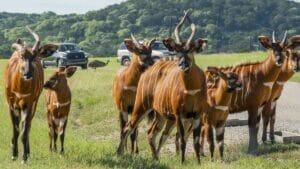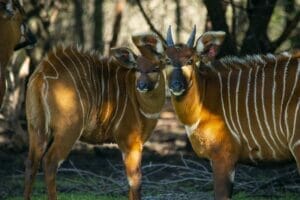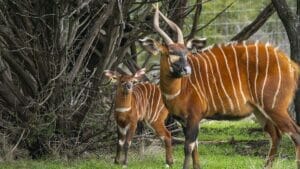
Appearance
The Eastern mountain bongo is a striking coppery-red antelope with thin white stripes. These stripes vary in number between individuals, but there are usually between 10 and 15 stripes per side. Female bongo are typically brighter in color than the males, who tend to have a smokier appearance. Both sexes have spiraled, lyre-shaped horns, though the males are large and thicker. They are the heaviest and most colorful African forest antelope.
Adaptations
The distinctive red coloration of eastern mountain bongos may not only serve as a means of identification, but unique camouflage. Despite what you may think, As the sun sets red colors become one of the first to fade as the sky takes on more blue hues. This, combined with the thick underbrush of their forest homes may help them blend into their surroundings as night falls.
Despite their size, bongo are quite timid and easily frightened. They will quickly run away after a scare and seek cover, where they stand still and alert with their backs to the disturbance. Their hindquarters are less conspicuous than the forequarters, and from this position, the animal can quickly flee.
In order to swiftly maneuver through the dense forest vegetation, bongos tilt their chins up so that their horns lie flat against their back. They take this position so frequently that older bongo often have bald spots on their back from the tips of their horns rubbing away their fur.
Conservation
The true wild numbers of eastern mountain bongo are debated, as these are very secretive animals. Even researchers who specifically study these antelope often do not see them in person, and tracking them is difficult in their densely packed forest homes. Much of what is known about bongo comes from captive animals and studies at salt licks on the edge of forests.
Poaching, habitat destruction, and illegal trapping for food and skins have resulted in the decline of bongo populations. Fortunately, there have been focused conservation efforts over the last few decades to help protect the species. A robust captive population and full protection under the Kenyan Wildlife Service have helped increase bongo numbers in the wild. Captive individuals from America have even been used as part of reintroduction efforts. In January of 2004, the first captive bongos were moved to the Mount Kenya Wildlife Conservancy.
.
Where are they?
Unless you visit early or late in the day, the bongo will most likely be on the far side of the second pasture you enter, in the wooded area.
VIEWING TIPS
Visiting in the early morning or evening will give you the best chance of viewing these antelope outside of the trees.
Quick Facts
Scientific Name | Tragelaphus eurycerus |
Species Survival Plan | Yes |
Habitat | Tropical jungles with dense undergrowth |
Food | Leaves, shoots and grasses |
Originally Native To | Congo Basin |
Characteristics | Red chestnut coat, 10-15 vertical stripes; lyre-shaped horns in both sexes |
Lifespan | Wild ? |
Social Behavior | Solitary, in pairs or small groups of 9 or less; females and young |





